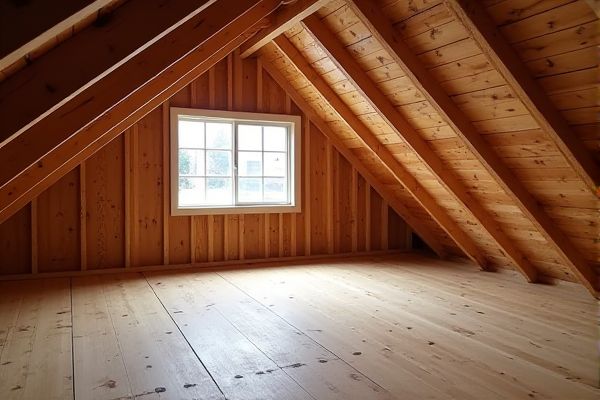
A finished attic offers insulated walls, flooring, and often lighting, making it a livable space perfect for bedrooms, offices, or storage, whereas an unfinished attic remains raw and typically used only for basic storage without comfort features. Explore the rest of the article to understand how choosing between a finished attic and an unfinished attic can impact your home's value, energy efficiency, and usability.
Table of Comparison
| Feature | Finished Attic | Unfinished Attic |
|---|---|---|
| Purpose | Usable living space (bedroom, office, storage) | Storage or mechanical space |
| Insulation | Fully insulated and climate-controlled | Minimal or no insulation |
| Flooring | Finished flooring (carpet, hardwood, etc.) | Exposed joists or plywood |
| Electrical & Lighting | Installed lighting and electrical outlets | Limited or no electrical fixtures |
| Access | Permanent staircase or improved access | Pull-down stairs or ladder |
| Cost | Higher renovation or finishing costs | Lower initial cost, less maintenance |
| Home Value Impact | Increases usable square footage and home value | No significant impact on home value |
| Building Codes | Must meet building codes and permits | Minimal code requirements |
Introduction to Finished vs Unfinished Attics
Finished attics are fully insulated and drywalled spaces designed for living purposes, often including flooring, lighting, and heating systems. Unfinished attics typically consist of exposed rafters, insulation, and bare floors, serving mainly as storage areas. Understanding the differences helps homeowners evaluate potential uses, renovation costs, and energy efficiency improvements.
Key Differences Between Finished and Unfinished Attics
A finished attic features completed walls, flooring, and insulation, making it suitable for living space, while an unfinished attic typically has exposed framing, minimal insulation, and is used for storage. Finished attics generally increase home value and require investments in HVAC, electrical systems, and permits, whereas unfinished attics involve lower costs but lack comfort and functionality. The decision between finished and unfinished attics depends on intended use, budget, and potential return on investment.
Pros and Cons of Finished Attics
Finished attics offer increased living space, enhanced home value, and improved insulation, making them ideal for bedrooms or home offices. However, they require higher initial investment, potential structural modifications, and regular maintenance to ensure proper ventilation and safety. Your decision should weigh these benefits against costs and intended use to maximize functionality and comfort.
Pros and Cons of Unfinished Attics
Unfinished attics provide flexible storage options and cost savings due to the absence of insulation, drywall, and flooring installation. You may face challenges such as limited temperature control, potential pest issues, and restricted usability compared to finished attics that offer improved living space and energy efficiency. Deciding between an unfinished or finished attic depends on your budget, storage needs, and plans for future home expansion.
Cost Comparison: Finished vs Unfinished Attic
Finished attics typically cost between $30 to $75 per square foot due to expenses like insulation, drywall, flooring, and electrical work, whereas unfinished attics may only require $5 to $15 per square foot primarily for cleaning and minor repairs. Your decision to finish an attic impacts overall home value, with finished spaces increasing livable square footage and market appeal, but at a higher upfront investment. Cost efficiency depends on your intended use and budget, as unfinished attics offer storage flexibility with minimal expense but lack comfort and usability.
Energy Efficiency and Insulation Considerations
Finished attics often feature enhanced insulation materials such as spray foam or fiberglass batts that improve energy efficiency by reducing heat loss and maintaining consistent indoor temperatures. Unfinished attics typically lack proper insulation, leading to increased energy consumption as heating and cooling systems work harder to compensate for temperature fluctuations. Investing in a finished attic can significantly lower utility bills by optimizing thermal performance and minimizing air leaks.
Usability and Functional Space Options
Finished attics provide versatile usable space such as bedrooms, offices, or playrooms, enhancing overall home functionality and increasing property value. Unfinished attics offer flexible storage options but often lack insulation, proper flooring, and lighting, limiting usability to basic storage or utility access. Converting an unfinished attic to a finished space requires investment in insulation, drywall, and electrical work to maximize functional benefits.
Impact on Home Value and Resale
Finished attics significantly boost home value and resale potential by providing additional livable square footage that appeals to buyers seeking extra bedrooms, offices, or recreational spaces. Unfinished attics offer storage but typically add minimal value, requiring costly renovations to meet buyer expectations for functional living areas. Your decision to finish an attic can enhance marketability and justify a higher asking price in competitive real estate markets.
Maintenance and Upkeep Requirements
Finished attics require regular cleaning, painting touch-ups, and maintenance of HVAC systems to ensure comfort and usability, while unfinished attics primarily need routine inspections for pests, moisture, and structural integrity. Your finished attic will likely demand higher upkeep costs due to flooring, insulation, and electrical components, whereas unfinished attics often have lower maintenance expenses but limited functionality. Proper ventilation and occasional repairs in both types prevent mold growth and damage, preserving overall home health.
Choosing the Right Attic Option for Your Home
Choosing between a finished attic and an unfinished attic depends on your home's needs, budget, and future plans. Finished attics provide additional living space, increase home value, and improve energy efficiency through proper insulation. Unfinished attics offer affordable storage options and flexibility for future renovations, requiring less initial investment but lacking immediate usability.
 homyna.com
homyna.com